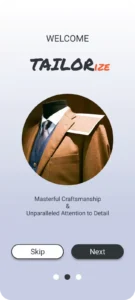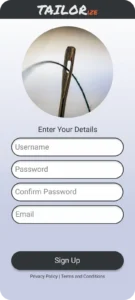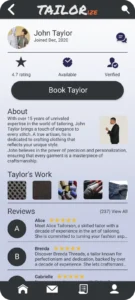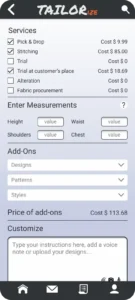A mobile app to order personalized tailoring services
Native Mobile App (iOS)
Islamabad, Pakistan
Portfolio Project
Designer, Researcher
E-Commerce, Fashion
June 2023 – August 2023
I am a big fan of tailored garments with embroidery and customized designs. The purpose of this app is to allow people to easily find and order tailoring services from local service providers.

The fashion trends are always changing and evolving all around the world. Since late 2022, there’s a growing trend of preference for customized styling and tailored suiting over off the rack, ready to wear apparel. There’s no clear line separating the market share for the two segments, but each have a sizable contribution.
Due to scarcity of skilled and experienced craftsmen, people find it challenging to obtain high quality of services. This leads to multiple reworks, delays in order delivery and unsatisfied customers.

I analyzed 3 most popular apps in the online tailoring space to identify strengths, weaknesses and opportunities for differentiation – looking both at the ordering experience and the negative customer feedback to find opportunities and market gaps.



I conducted a quick survey among people who are eco-conscious on Twitter about what is the most important thing for the people using products in this category. The survey supported the assumption that people pick ready to wear clothes due to their need for convenience and most people like to customize their clothing down to the most minute details. The limiting factors are the price and scarcity of skilled resources.

There’s a growing need for a convenient, easy to use, affordable service with verified credentials and fast delivery available for customers.
Developed detailed personas based on user research to empathize with target audience segments.
“As an influencer I would love to expand my career and I welcome anything that helps me achieve my goals” Christy
Christy is a social media influencer who lives in Lakewood, Colorado. Christy lives with her parents and shares her room with her sibling. In the mornings, Christy spends time in the gym and likes to eat healthy food. Majority of the time in her day is spent in studios for her photo and video shoots. She loves to dress up and go out to parties and dinners for which she frequently needs new dresses. Christy is a budget conscious person and keeps a close watch on her cash flows.
“If given a chance I would like to handle things on my own instead of depending on others, same goes for my custom clothing wardrobe. I’m actively looking to switch my tailor.” Mathew
Mathew is a studio-owner who lives in Omaha, Nebraska. He lives with his wife who is a working professional doing 9-5 on weekdays. His 2 kinds are studying in high school. Mathew manages the studio from home and his staff comes in every morning to work. He has dedicated a portion of his residence for office and work area.
Majority of his day is spent with his team of workers, serving his clients and managing various tasks. On weekends he loves to go out and spend time with his family.
Mathew finds it difficult to keep his business afloat with rising costs, unavailability of skilled labor and wants to cut down on expenses.
To outline all the necessary functions, several flow diagrams were created describing the user flow for different use cases. One of these flows is shown below. Due to space constraints, the flow diagram does not show the fail conditions.
Once all the user flows were finalized, the low fidelity wireframes were created according to the main user flow and additional use cases.

Once the initial user flows and wireframes were finalized, I started converting these concepts into high fidelity designs. But first I incorporated brand elements, color definitions and typography for a cohesive user experience.


In order to explore different navigation patterns and user experience, 2 separate navigation patterns were created out of which 1 was picked for the final user flow. Between 2 designs, 34 different High Fidelity design screens were created.














After the high fidelity UI design was finalized and ready, the prototypes for different use cases and user flows were created. The main user flow is shown here in the iframe below. Due to limitations from Figma, the prototype can only be viewed on desktop devices.
Click here to view the prototype in Figma. Only works on desktop.
In order to validate the prototype based on usability I planned a small unmoderated usability study and involved 5 individuals with at least one individual who needed assistive technologies. The research plan can be seen here
The research goals were to find out if users can finish the core tasks of finding and booking a tailor. In addition to that several sub goals were also planned like the duration it takes a user to search and book an order. Any part of process where user gets stuck or is lost. Any essential use case that might be missing.
The key performance indicators for this study are: Time On Task, User Error Rates, Drop-Off Rates, System Usability Scale.
This study was conducted as unmoderated session where participants were asked to perform various tasks using the prototype and record their screens while doing so. After the session was over a questionnaire was filled by the participants.
The key performance indicators for this study are: Time On Task, User Error Rates, Drop-Off Rates, System Usability Scale.
This study was conducted as unmoderated session where participants were asked to perform various tasks using the prototype and record their screens while doing so. After the session was over a questionnaire was filled by the participants.
Accessibility guidelines were rigorously followed to ensure the design was inclusive and accessible to users of all abilities, promoting equal access and usability. The app has been evaluated for contrast to match the AA standard of WCAG. However, some areas needed improvements.
Need to include screen reader option in the app to accommodate for users with impaired hearing
A dedicated help & support section built in the app to answer user questions
High contrast mode and dark/light mode option to make it accessible for users with sight impairment
During this project, I learned to evaluate the market, do a quick user survey online, analyze competitors to identify gaps and opportunities, perform a mini usability study, create a set of low fidelity wireframes and turned them into high fidelity prototype of a beautiful UI design.
